Foreword / YouTube Video Review
This pair of speakers was loaned to me by the manufacturer for review. I was not paid to conduct this review and the manufacturer has not seen this data before public release.
All my reviews are done on my own time with great care to give you all the best set of data and information I can provide in order to help you make a well-informed purchase decision. I offer this for free to all who are interested. In return, if you want to support this site please see the bottom of this review for ways you can help. It is greatly appreciated.
The review on this website is a brief overview and summary of the objective performance of this speaker. It is not intended to be a deep dive. Moreso, this is information for those who prefer “just the facts” and prefer to have the data without the filler. The video below has more discussion with respect to the technical merits and subjective notes I had during my listening sessions.
Information
Some specs from the manufacturer can be found here.
- Product Weight: 33 lbs/15 Kgs
- Frequency Response (+/-3 dB)40-35,000 Hz
- Impedance 4 Ohms
- Sensitivity 87 dB
- Crossover 900 Hz between woofers and mids, 2.3 kHz between mids and tweeters
- Power Range 150-300 Watts
- Recommended Amplifier Power 20-150 Watts
- Tweeter 1.1" Custom Aperion ASR Tweeter with ferrofluid
- Midrange One 4" Woven Kevlar Woofer with Aluminum Phase Plug
- Woofer Two 6.5" Woven Kevlar Woofers with PVC Dust Cap and Rubber Surrounds
- Driver Configuration 3-Way
- Enclosure Type Anti-Resonant, Internally Braced, Sealed
- Product Dimensions 9.25" H (w/ rubber feet) x 24.75" W x 11" D/235mm H x 629mm W x 279mm D
Retail is $799 USD.
CTA-2034 (SPINORAMA) and Accompanying Data
All data collected using Klippel’s Near-Field Scanner. The Near-Field-Scanner 3D (NFS) offers a fully automated acoustic measurement of direct sound radiated from the source under test. The radiated sound is determined in any desired distance and angle in the 3D space outside the scanning surface. Directivity, sound power, SPL response and many more key figures are obtained for any kind of loudspeaker and audio system in near field applications (e.g. studio monitors, mobile devices) as well as far field applications (e.g. professional audio systems). Utilizing a minimum of measurement points, a comprehensive data set is generated containing the loudspeaker’s high resolution, free field sound radiation in the near and far field. For a detailed explanation of how the NFS works and the science behind it, please watch the below discussion with designer Christian Bellmann:
IMPORTANT SETUP INFO:
This speaker was measured with the reference point at the tweeter and with the grille off (I did test with the grille on and the results were much worse, as expected).
Measurements are provided in a format in accordance with the Standard Method of Measurement for In-Home Loudspeakers (ANSI/CTA-2034-A R-2020). For more information, please see this link.
CTA-2034 / SPINORAMA:
The On-axis Frequency Response (0°) is the universal starting point and in many situations it is a fair representation of the first sound to arrive at a listener’s ears.
The Listening Window is a spatial average of the nine amplitude responses in the ±10º vertical and ±30º horizontal angular range. This encompasses those listeners who sit within a typical home theater audience, as well as those who disregard the normal rules when listening alone.
The Early Reflections curve is an estimate of all single-bounce, first-reflections, in a typical listening room.
Sound Power represents all of the sounds arriving at the listening position after any number of reflections from any direction. It is the weighted rms average of all 70 measurements, with individual measurements weighted according to the portion of the spherical surface that they represent.
Sound Power Directivity Index (SPDI): In this standard the SPDI is defined as the difference between the listening window curve and the sound power curve.
Early Reflections Directivity Index (EPDI): is defined as the difference between the listening window curve and the early reflections curve. In small rooms, early reflections figure prominently in what is measured and heard in the room so this curve may provide insights into potential sound quality.
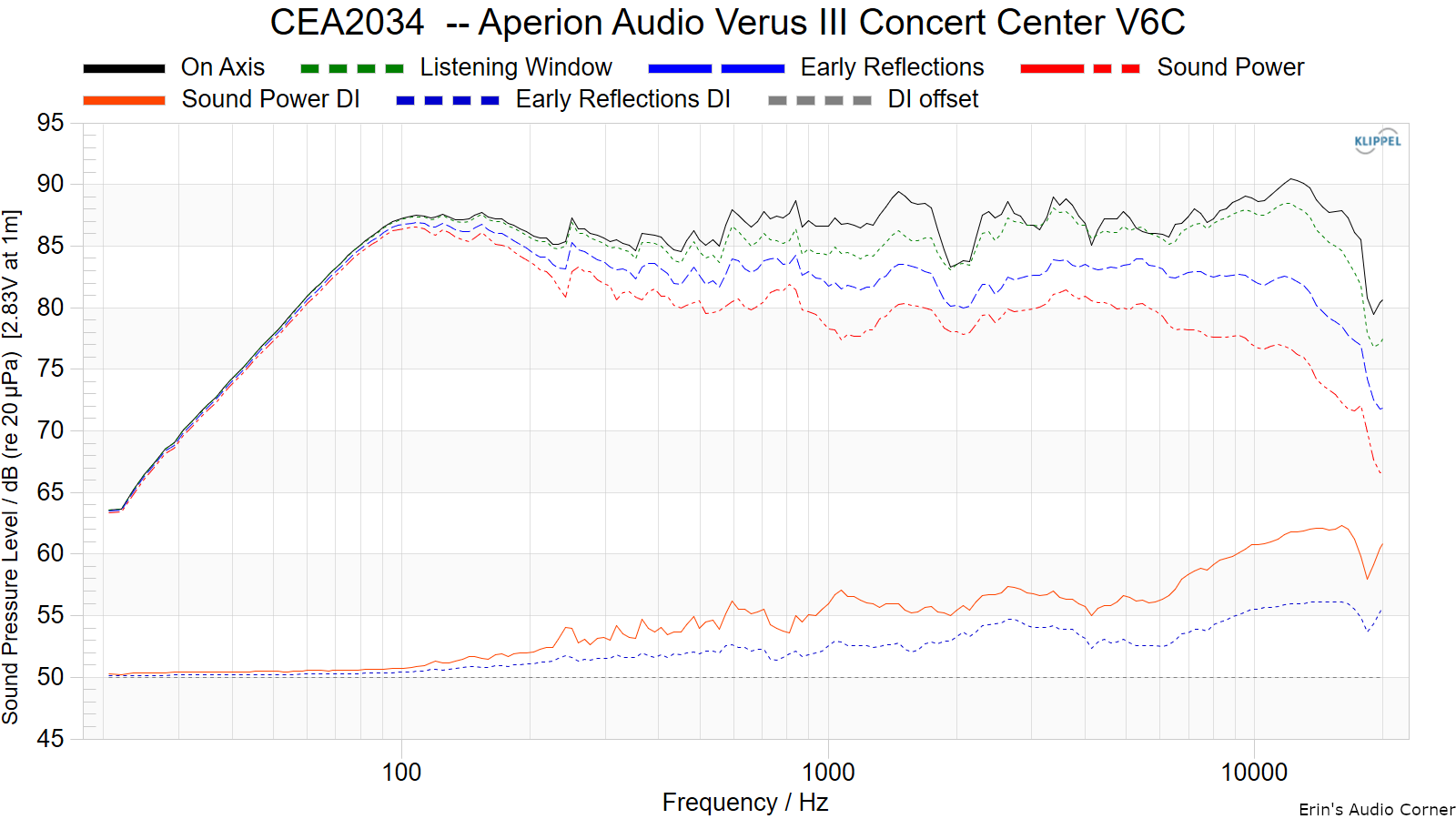
Early Reflections Breakout:
Floor bounce: average of 20º, 30º, 40º down
Ceiling bounce: average of 40º, 50º, 60º up
Front wall bounce: average of 0º, ± 10º, ± 20º, ± 30º horizontal
Side wall bounces: average of ± 40º, ± 50º, ± 60º, ± 70º, ± 80º horizontal
Rear wall bounces: average of 180º, ± 90º horizontal

Estimated In-Room Response:
In theory, with complete 360-degree anechoic data on a loudspeaker and sufficient acoustical and geometrical data on the listening room and its layout it would be possible to estimate with good precision what would be measured by an omnidirectional microphone located in the listening area of that room. By making some simplifying assumptions about the listening space, the data set described above permits a usefully accurate preview of how a given loudspeaker might perform in a typical domestic listening room. Obviously, there are no guarantees, because individual rooms can be acoustically aberrant. Sometimes rooms are excessively reflective (“live”) as happens in certain hot, humid climates, with certain styles of interior décor and in under-furnished rooms. Sometimes rooms are excessively “dead” as in other styles of décor and in some custom home theaters where acoustical treatment has been used excessively. This form of post processing is offered only as an estimate of what might happen in a domestic living space with carpet on the floor and a “normal” amount of seating, drapes and cabinetry.
For these limited circumstances it has been found that a usefully accurate Predicted In-Room (PIR) amplitude response, also known as a “room curve” is obtained by a weighted average consisting of 12 % listening window, 44 % early reflections and 44 % sound power. At very high frequencies errors can creep in because of excessive absorption, microphone directivity, and room geometry. These discrepancies are not considered to be of great importance.

Horizontal Frequency Response (0° to ±90°):

Vertical Frequency Response (0° to ±40°):

Horizontal Contour Plot (normalized):
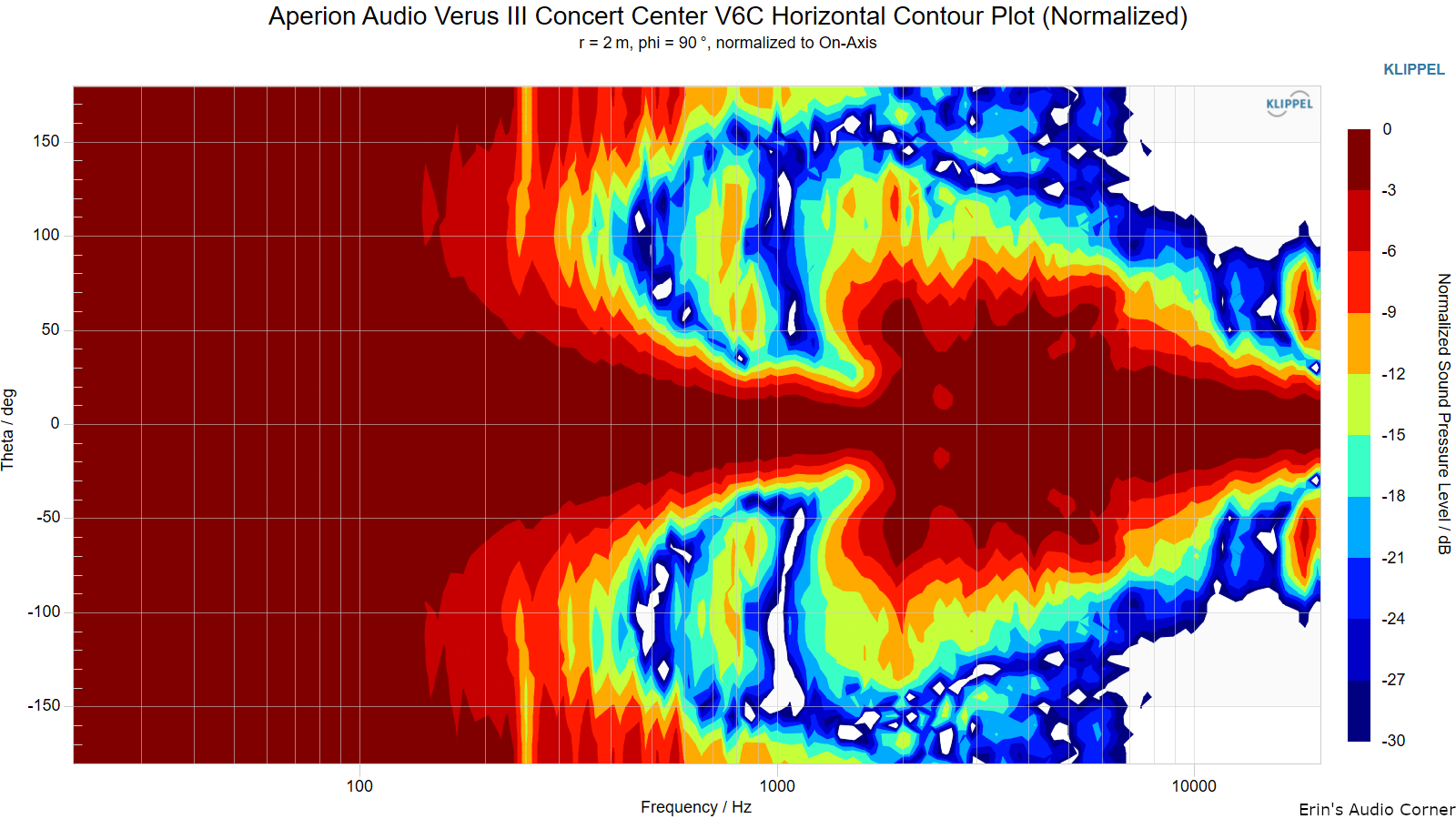
Vertical Contour Plot (normalized):
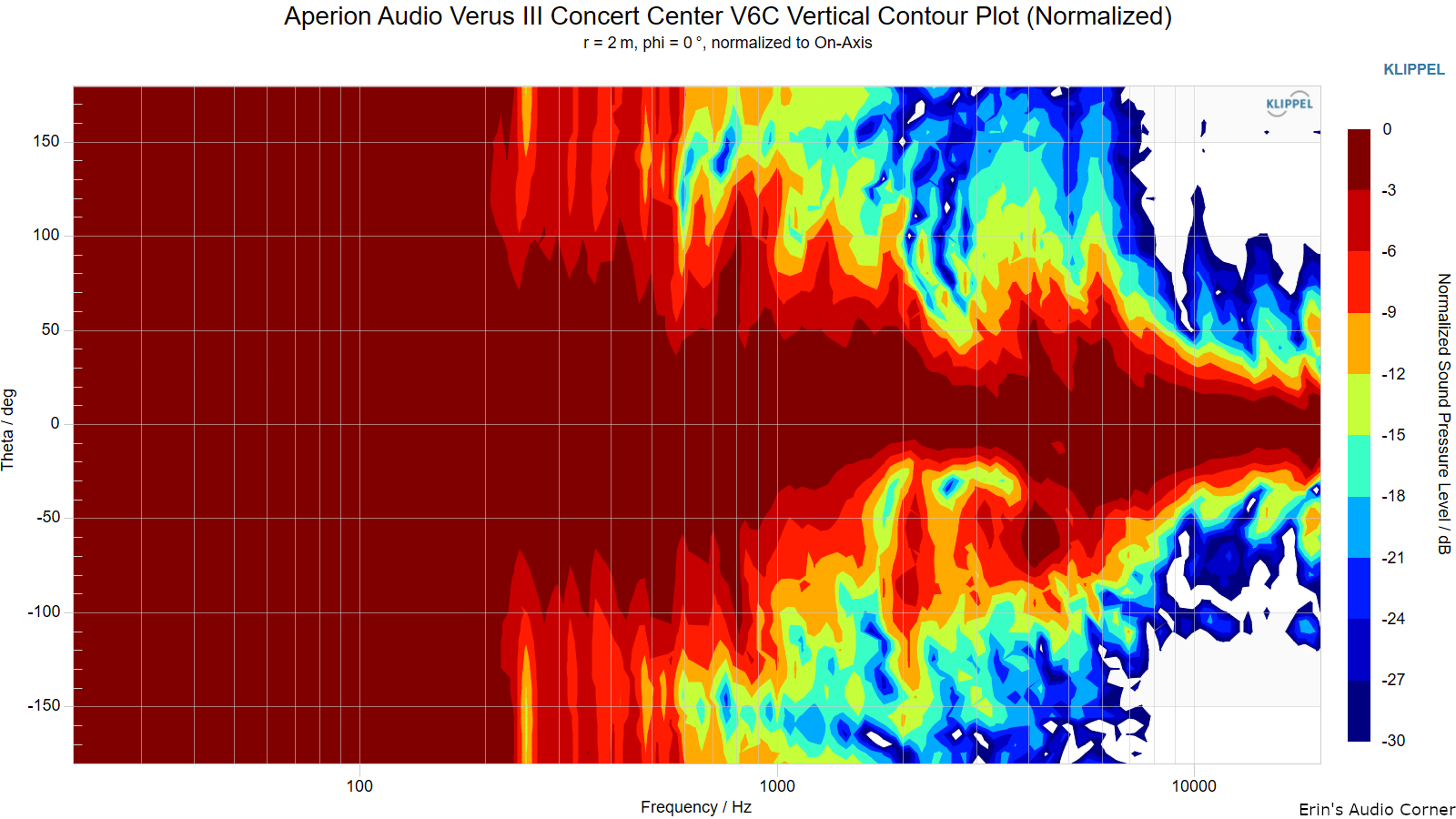
“Globe” Plots
Horizontal Polar (Globe) Plot:
This represents the sound field at 2 meters - above 200Hz - per the legend in the upper left.
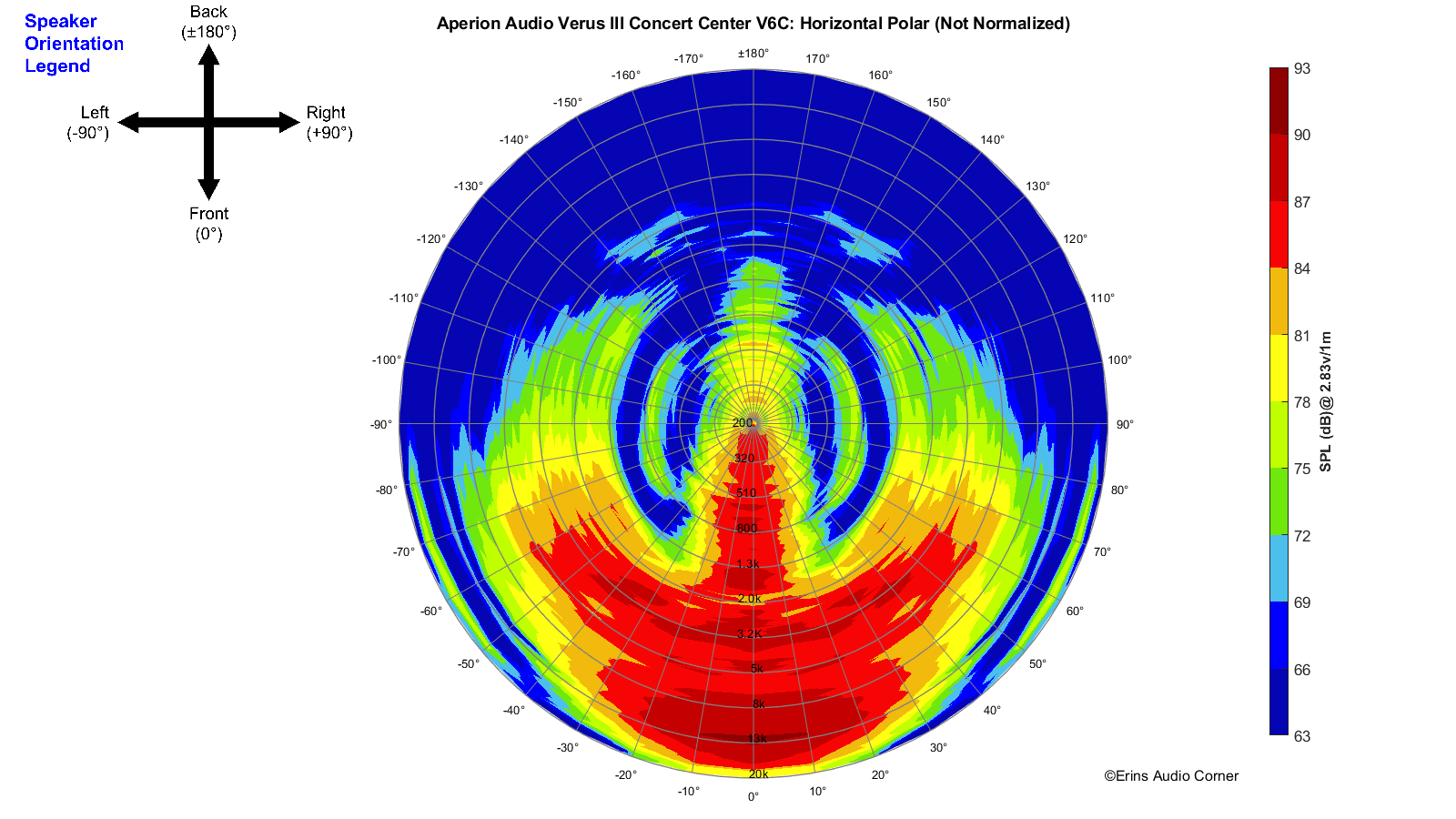
Vertical Polar (Globe) Plot:
This represents the sound field at 2 meters - above 200Hz - per the legend in the upper left.
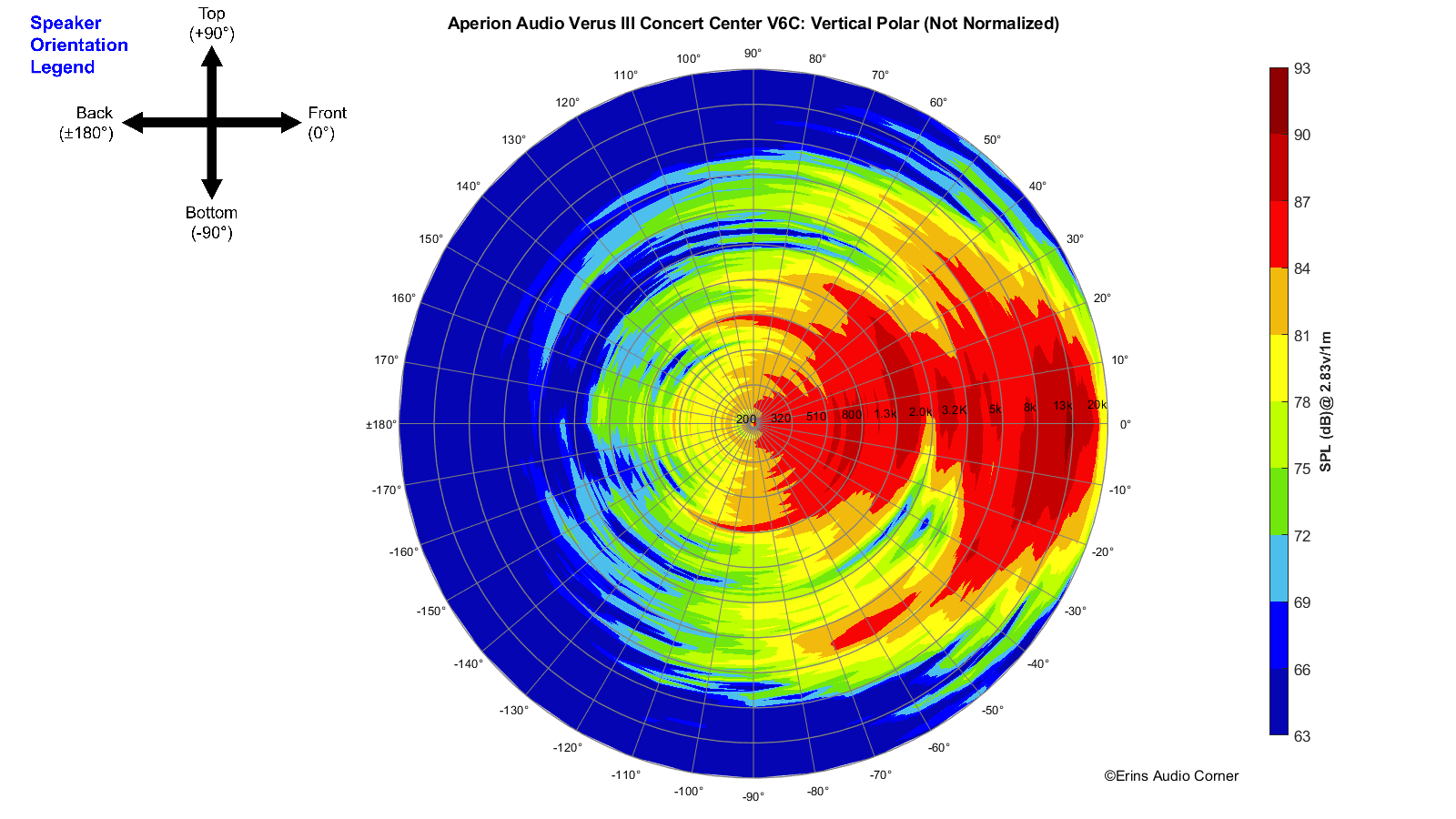
Additional Measurements
Impedance
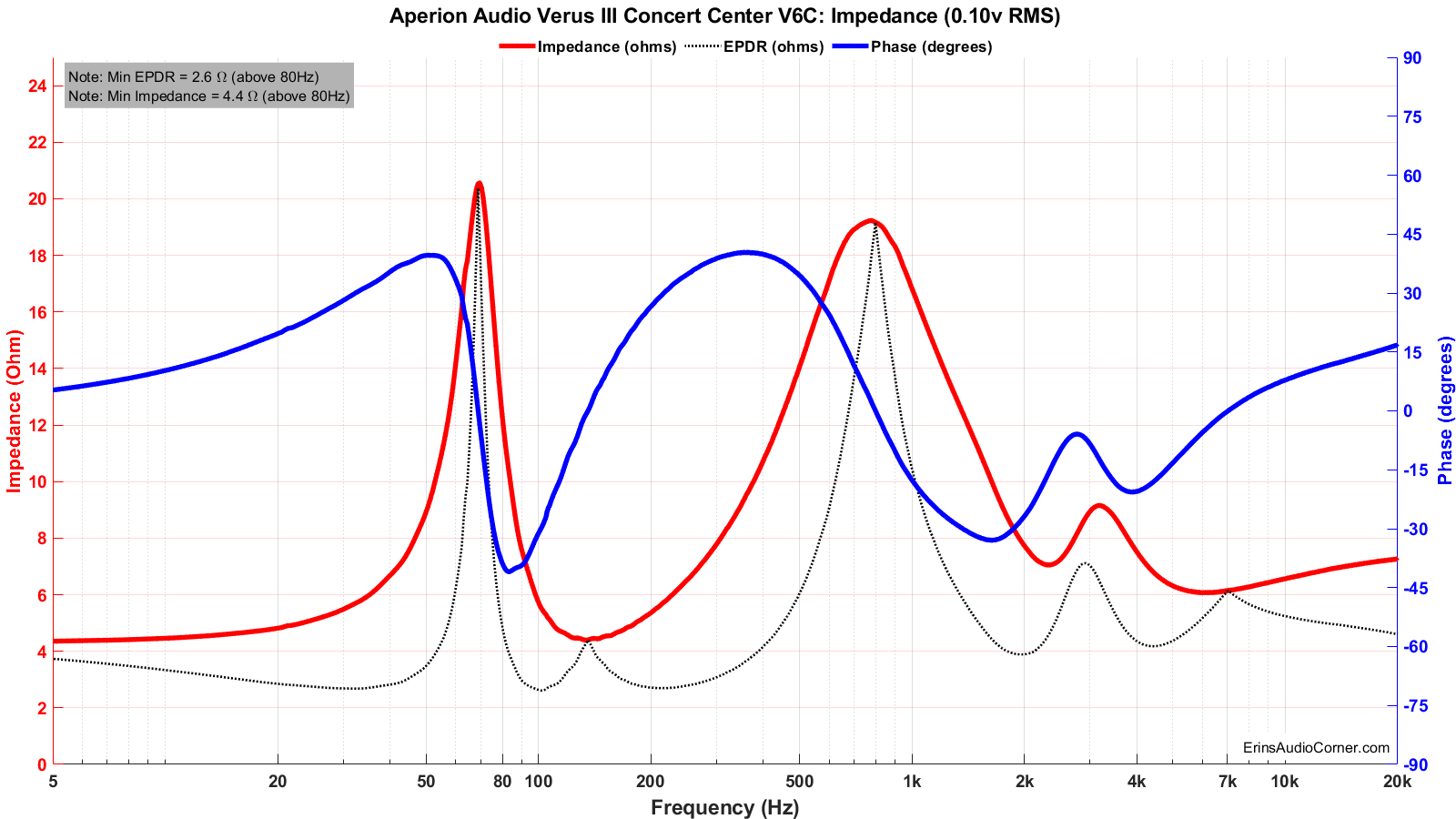
Response Linearity
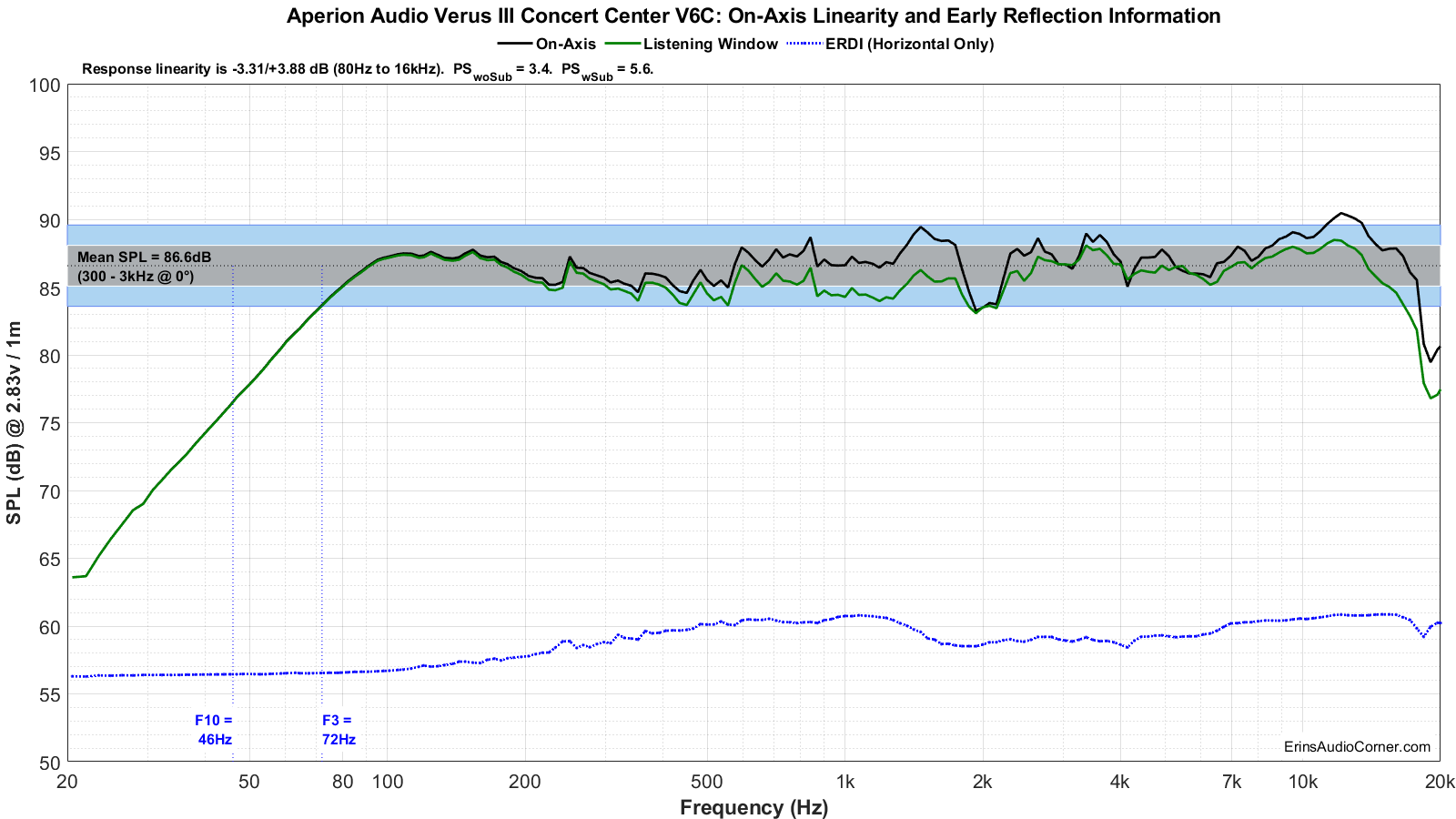
Step Response

Group Delay
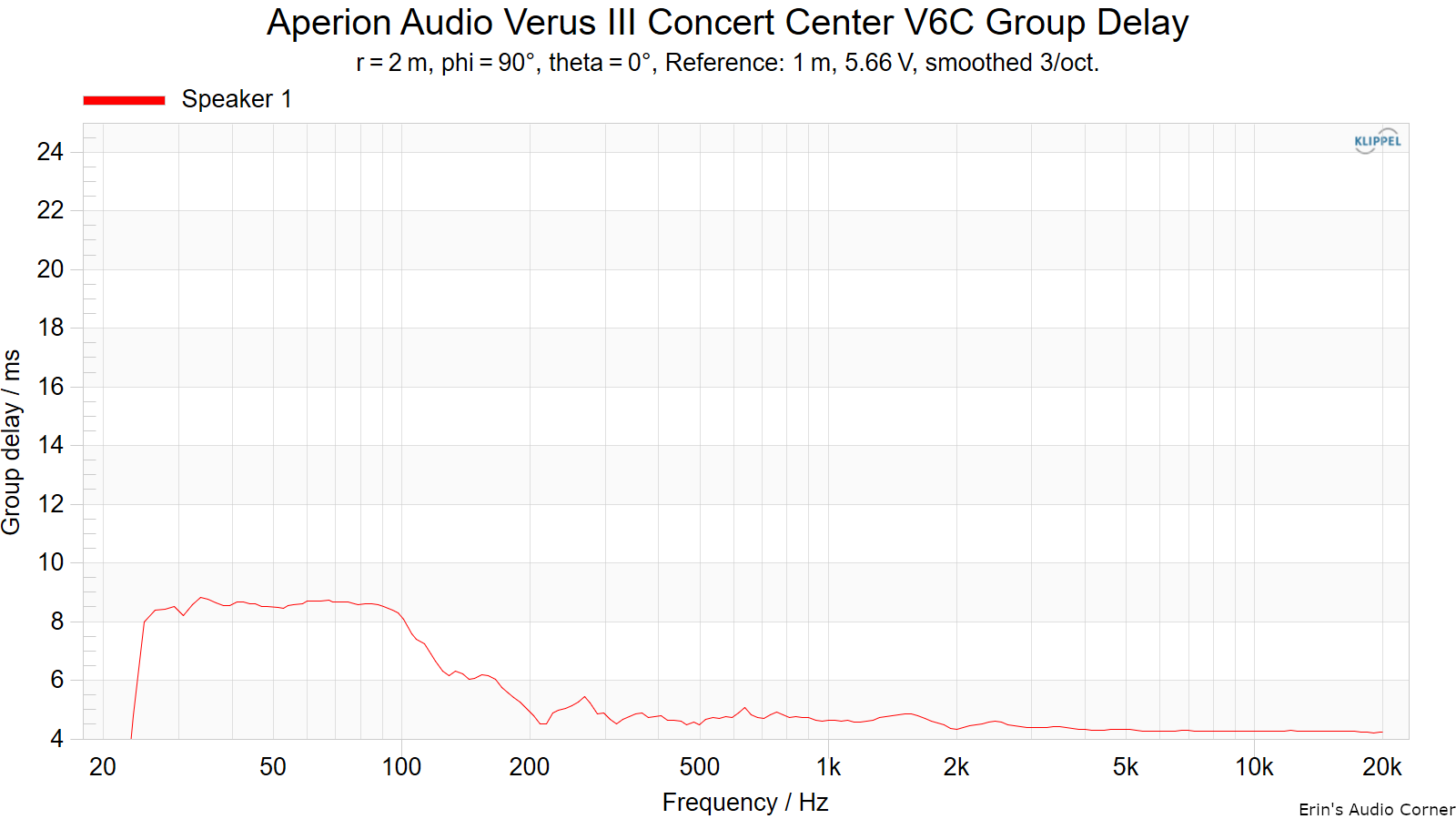
Harmonic Distortion
Harmonic Distortion at 86dB @ 1m:
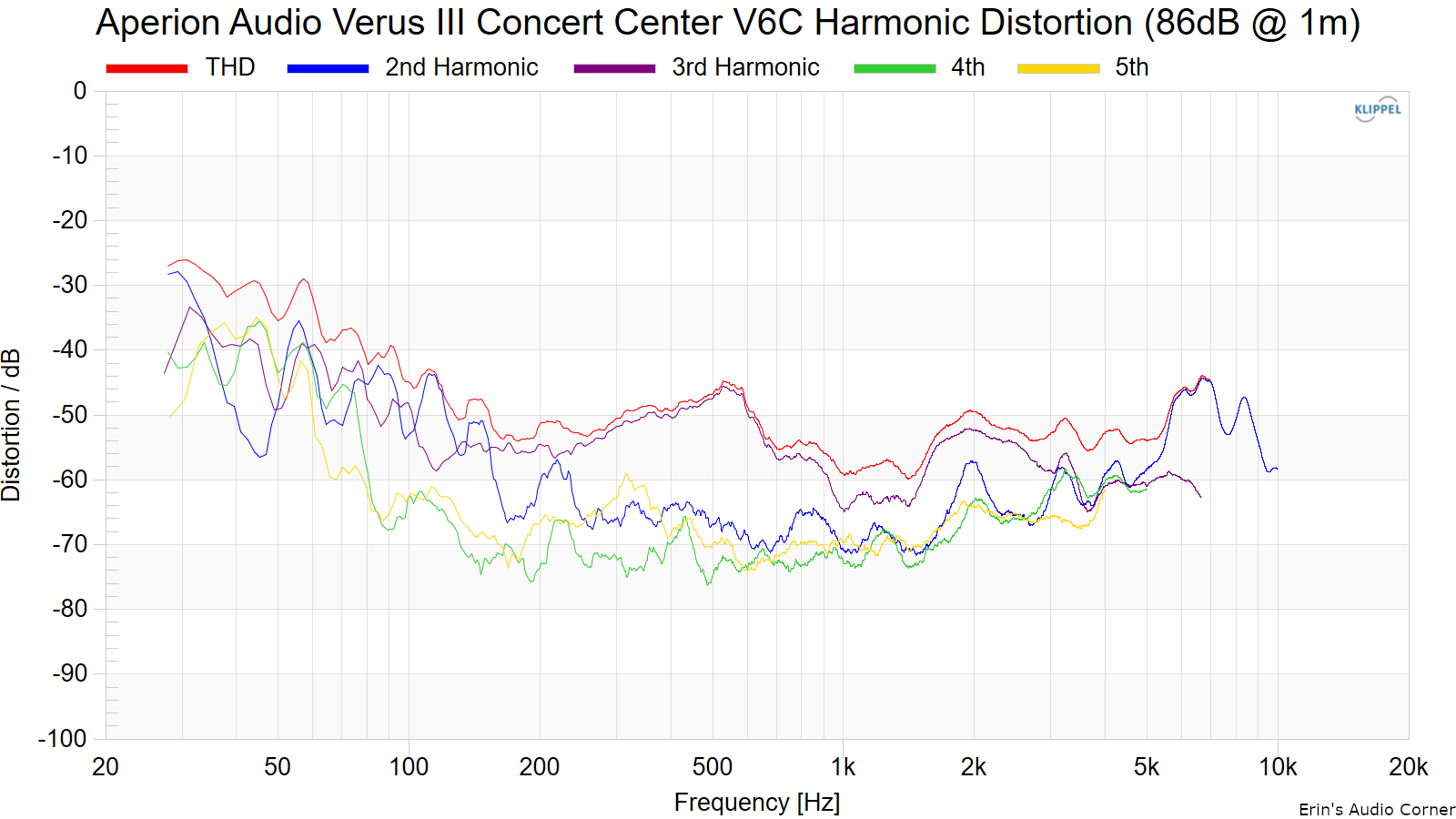
Harmonic Distortion at 96dB @ 1m:
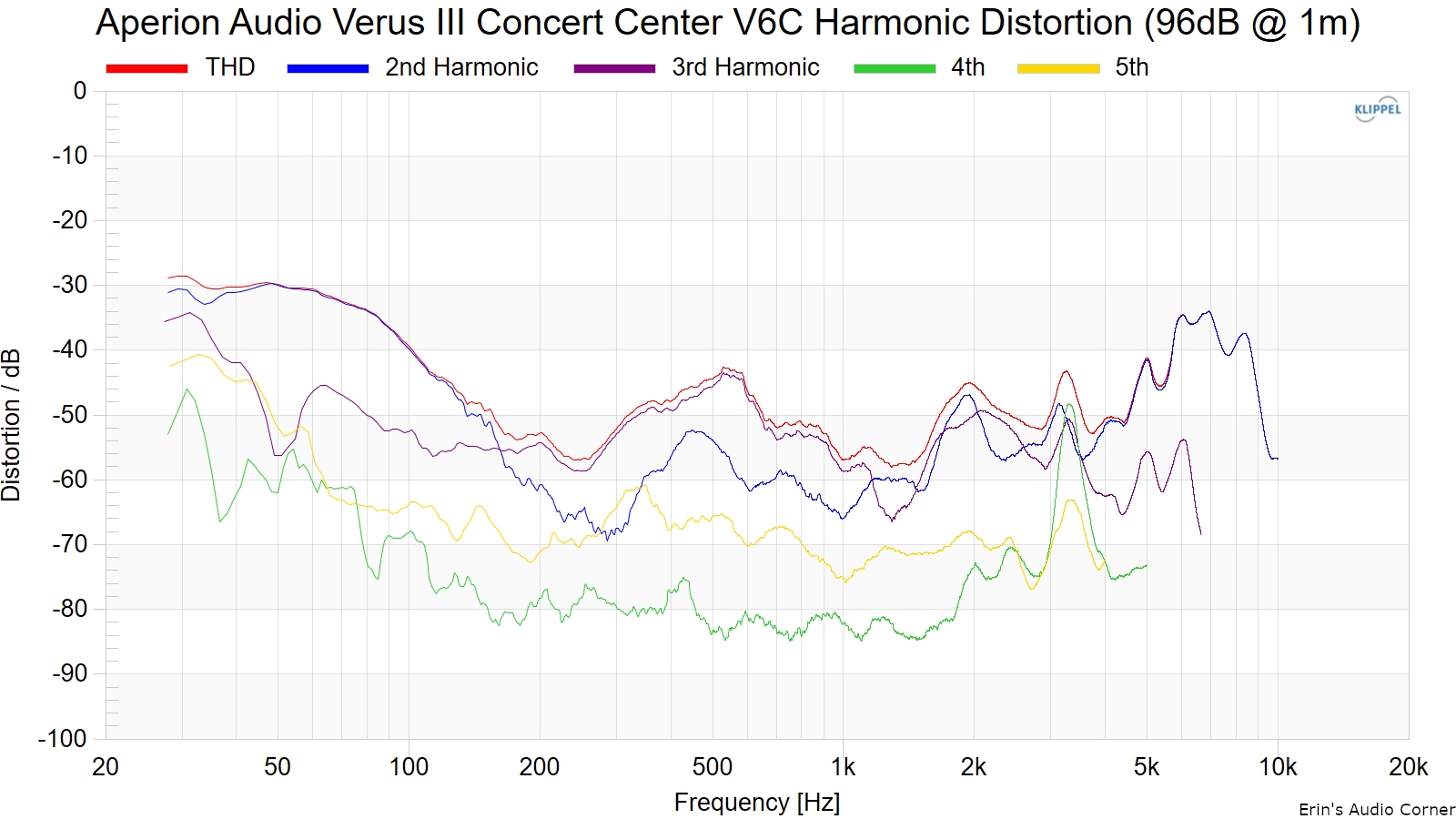
Dynamic Range (Instantaneous Compression Test)
The below graphic indicates just how much SPL is lost (compression) or gained (enhancement; usually due to distortion) when the speaker is played at higher output volumes instantly via a 2.7 second logarithmic sine sweep referenced to 76dB at 1 meter. The signals are played consecutively without any additional stimulus applied. Then normalized against the 76dB result.
The tests are conducted in this fashion:
- 76dB at 1 meter (baseline; black)
- 86dB at 1 meter (red)
- 96dB at 1 meter (blue)
- 102dB at 1 meter (purple)
The purpose of this test is to illustrate how much (if at all) the output changes as a speaker’s components temperature increases (i.e., voice coils, crossover components) instantaneously.
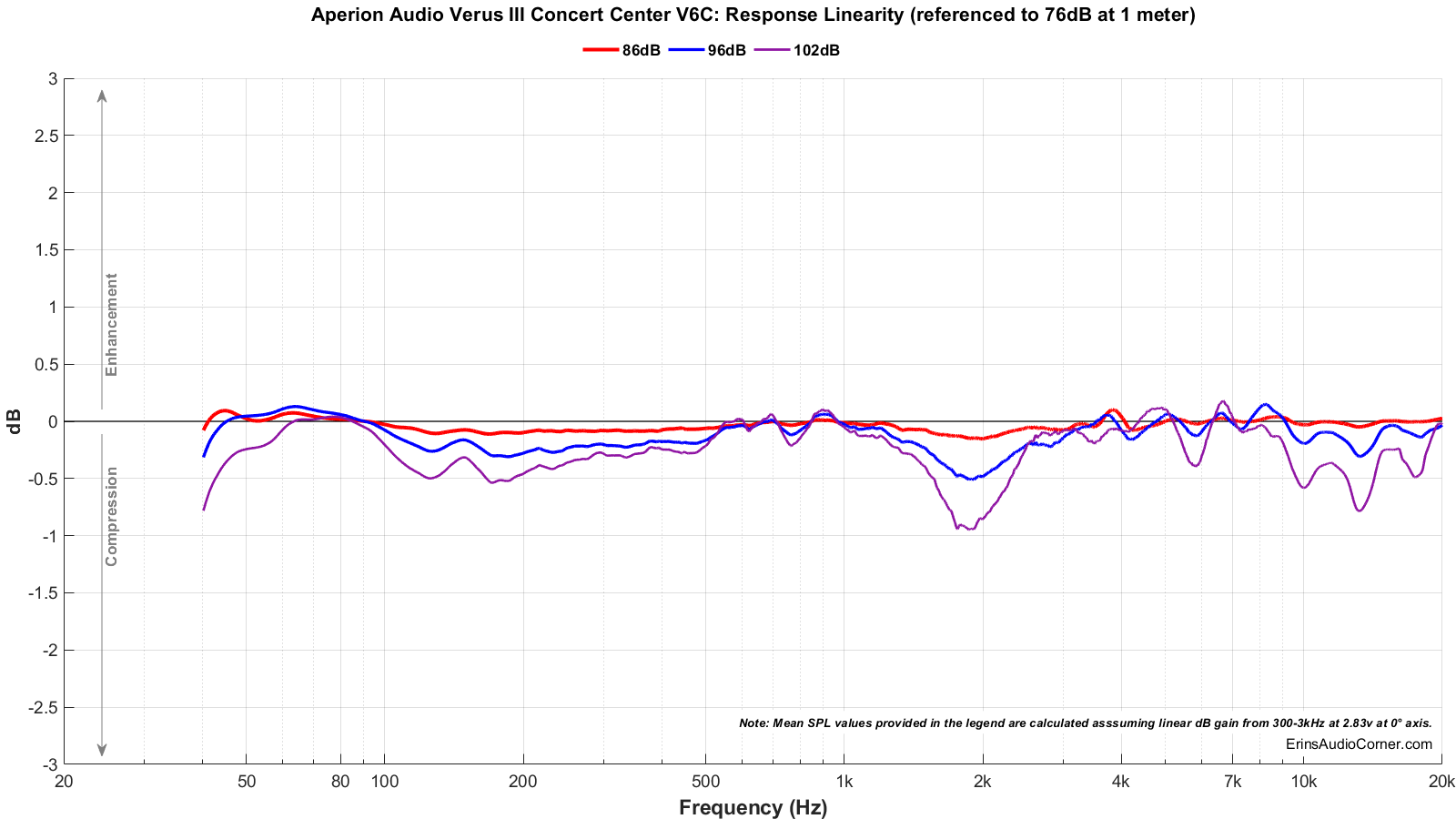
Multitone Distortion
The following tests are conducted at (4) approximate equivalent output volumes: 70/79/87/96dB @ 1 meter. The (4) voltages listed in the legend result in these SPL values.
The test was conducted in (3) manners:
- Full bandwidth (20Hz to 20kHz)
- 80Hz to 20kHz
The reason for the two measurements is to simulate running the speaker full range vs using a high-pass filter at 80Hz. However, note: the 2nd test low frequency limit at 80Hz is a “brick wall” and doesn’t quite emulate a standard filter of 12 or 24dB/octave. But… it’s close enough.
For information on how to read the below data, watch this video:
- Full bandwidth (20Hz to 20kHz)
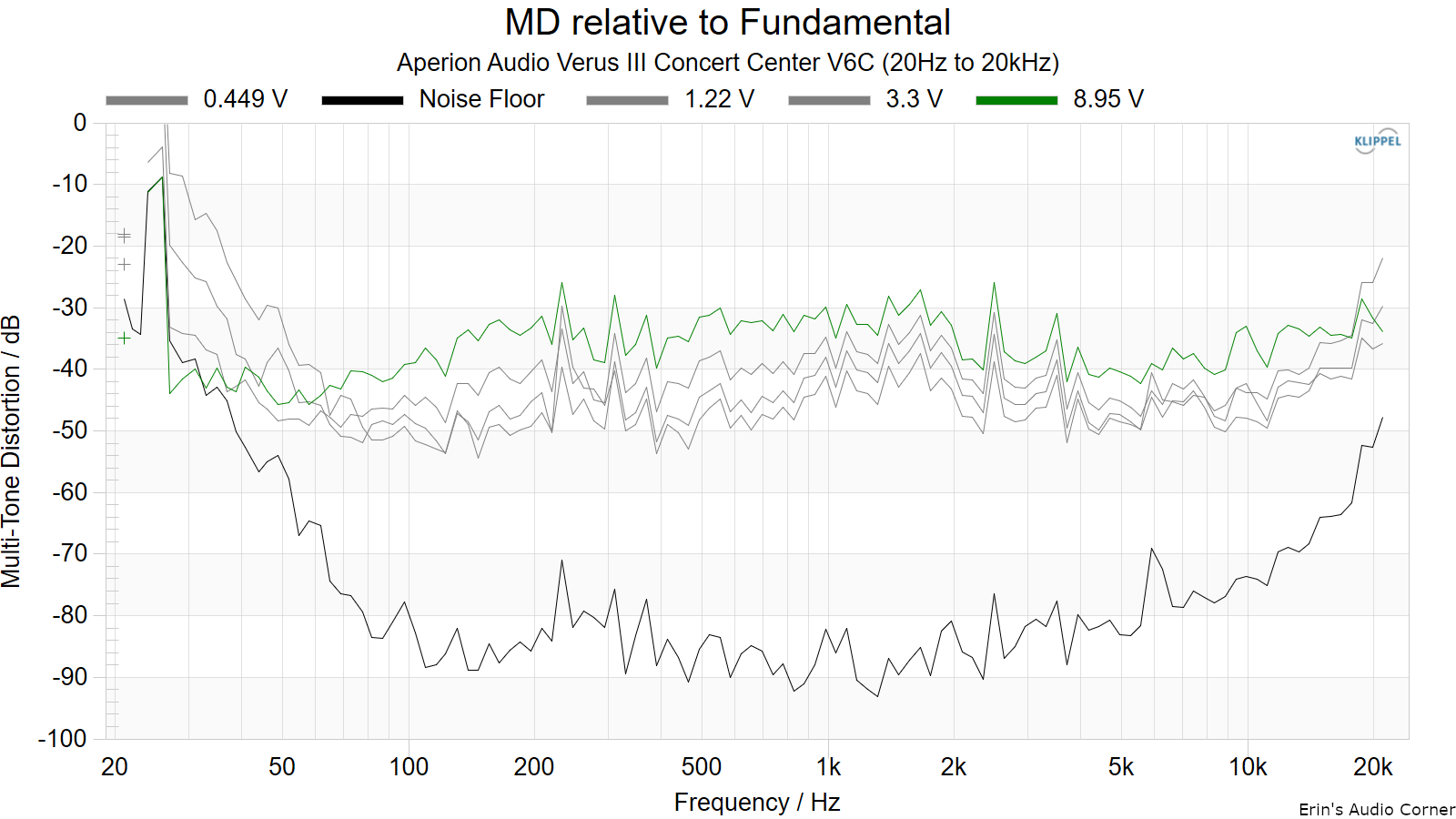
- 80Hz to 20kHz

Parting / Random Thoughts
See video linked above for subjective and objective analysis.
I am combining my discussion of the Verus III V8B bookshelf speaker and the matching center channel speaker here.
Pros: Aesthetic Design: The speakers have an appealing and visually pleasing design, especially in the wood finish. Low Bass Distortion: The bookshelf speakers exhibit low distortion in the bass region, providing clean and accurate low-frequency reproduction. Wide Radiation Pattern: The speakers offer a reasonably wide radiation pattern, enhancing the room involvement and soundstage. High-Quality Construction: The use of HDF enclosures instead of typical MDF enclosures adds to the durability and sturdiness of the speakers.
Cons: Mid-Range Scoop: The bookshelf speakers suffer from a significant mid-range scoop between 100 Hz and 500 Hz, resulting in a lack of richness and fullness in vocals. Resonant Peaks: The speakers exhibit resonant peaks in the high-frequency range, particularly around 4 kHz and 10 kHz. These peaks can lead to overemphasis and discomfort in certain tracks, affecting overall clarity and detail. Limited Equalization Options: While equalization can be used to address some of the speaker’s issues, the available adjustment range is limited, and it may be challenging to completely eliminate the mid-range scoop and resonant peaks. Crossover Issues (Center Speaker): The center speaker’s three-way design, although beneficial in theory, introduces horizontal radiation limitations, causing a decrease in speech intelligibility beyond approximately ±20 degrees off-axis.
Data Analysis: The data obtained from testing reveals some of the underlying causes behind the subjective listening experiences. The on-axis response shows the mid-range scoop and resonant peaks, which correlate with the perceived dull and imbalanced sound. The spinorama data highlights the impact of the speaker’s design on off-axis response and directivity index. Additionally, the estimated in-room response provides insights into the tonal balance and the presence of peaks and dips. The distortion measurements indicate low distortion levels for the bookshelf speakers, but compression issues are noticeable above 1 kHz.
Conclusion: While Aperion Audio’s Verus III bookshelf and center speakers offer some appealing features, such as aesthetic design, low bass distortion, and wide radiation patterns, they suffer from mid-range scoop and resonant peaks. These issues result in a dull and imbalanced sound reproduction, particularly in vocals and certain high-frequency elements. Although some of the problems can be partially addressed with equalization, the limitations and the relatively high price point of the speakers make it less desirable to rely on EQ adjustments. Furthermore, the center speaker’s design compromises speech intelligibility for listeners positioned beyond ±20 degrees off-axis. Overall, considering the speaker’s performance, it is recommended to explore other options in the market that offer better balance and clarity within a similar price range.
Support / Contribute
If you find this review helpful and want to help support the cause that would be AWESOME! There are a few ways you can do so below. Your support helps me pay for new items to test, hardware, miscellaneous items needed for testing, new speakers to review and costs of the site’s server space and bandwidth. Any help is very much appreciated.
Join my Patreon: Become a Patron!
Shopping
If you are shopping at any of the following stores then please consider using my generic affiliate links below to make the purchase through.
Purchases through these links can earn me a small commission - at no additional cost to you - and help me continue to provide the community with free content and reviews. Doesn’t matter if it’s a TV from Crutchfield, budget speakers from Audio Advice or a pair of socks from Amazon, just use the link above before you make your purchase. Thank you!
